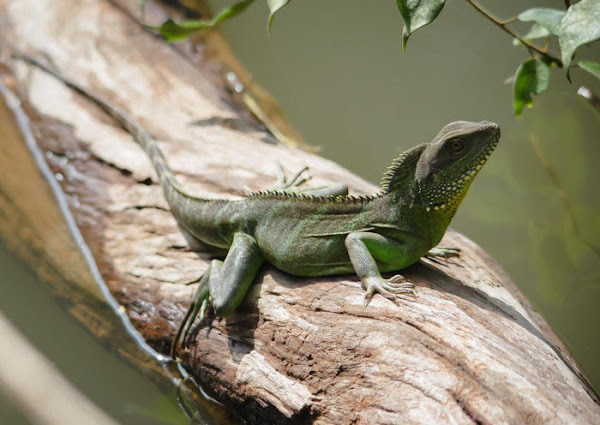Physignathus cocincinus (Green Water Dragon)
The common name of this Agamid Lizard in English is commonly called Thai Water Dragon, Green Water Dragon, Chinese Water Dragon, Asian Water Dragon and Thai name called ตะกอง (Dta-gong), ลั้ง (Lang), กิ้งก่ายักษ์ (Ging-gaa Yak).
ตะกอง : Physignathus cocincinus Cuvier, 1829
Physignathus cocincinus is a species of the Water Dragon Lizard Genus (Physignathus) within the Subfamily Amphibolurinae, in the Agamid Lizard Family (Agamidae), Superfamily Iguania, in the Lizard and Snake Order (Squamata), in the Reptile Class (Reptilia), in the Chordate Phylum (Chordata) in the Animal Kingdom (Animalia).
Published in Cuvier, G. J. L. N. F. D. Le Regne Animal Distribué, d'apres son Organisation, pur servir de base à l'Histoire naturelle des Animaux et d'introduction à l'Anatomie Comparé. Nouvelle Edition [second edition]. Vol. 2. Les Reptiles. Déterville, Paris, i-xvi, 1-406. (1829).
The specific epithet 'cocincinus' given by CUVIER tried to latinize “Cochin China” which was the reason for GUÉRIN’s unjustified emendation to “cochinchinensis”. “Cochin China” is a name used by the French for the southernmost part of Vietnam.
Geographic Range
This species occurs throughout Lao PDR, Cambodia and Viet Nam in appropriate habitat. It has been found throughout eastern Thailand from the Eastern Forest Complex south to the coast, but only in protected areas (M. Cota pers. comm. 2017), and is found in southern China, in the southwest part of Guangdong, Guangxi, and Hekou in Yunnan.
It is believed to have an area of occupancy below 500 km in China. It has been introduced to Taiwan (G. Norval, cited in Uetz 2017). It has been found from sea level up to 700 m asl (Stuart et al. 2006); Nguyen et al. (2018) report the species' presence in a section of stream with a maximum elevation of 770 m asl.
Habitat and Ecology
This species inhabits evergreen forest, where it is always found in association with streams and rivers. Animals are sedentary and exhibit strong site philopatry: Nguyen et al. (2018) found that capturing and releasing animals as part of a mark-recapture study did not cause them to abandon favoured perch sites.
Nguyen et al. (2018) found that the species was consistently less abundant at higher elevations in all survey sites, and hypothesized that this may relate to stream properties and water quality. It rests on the branches of trees overhanging the waterway, into which it will plunge to escape danger. It forages in the middle of the day for insects, earthworms, and small rodents.
Clutches comprise 8 to 12 eggs laid in exposed sandy areas on streambeds. It roosts overnight high up in streamside trees (Chan-ard et al. 2015). Although long-lived the species is relatively fast-growing, with juveniles reaching subadult size within two months (Nguyen et al. 2018).
This species inhabits tropical areas of China at around 100 m asl. Zhao et al. (1999) reported that the it is commonly found in forest and rocky streams. It lays about 6–14 eggs per clutch (Zhao et al. 1999).
Use and Trade
This species is harvested for food throughout most of its range, with both adults and eggs taken. It has been recorded in the domestic pet trade in Viet Nam (Nguyen et al. 2018). It is extremely common in the international pet trade, especially in Europe, and while the species is very widely captive-bred juveniles are taken from the wild for export, especially from Viet Nam.
The CITES Trade Database reports 44,741 animals exported from Viet Nam (over 43,000), Thailand and Indonesia (the origin of the 162 animals exported from Indonesia, where the species does not occur, is not reported) into European Union countries between 2010 and 2016; in every year but 2010 and 2015 annual exports exceeded 8,200. Imports show a slight declining trend over this period, but a longer time series will be necessary to determine whether this is significant.
The vast majority of these were live animals presumably intended for the pet trade, but the records include over 2,000 animals imported as skins or leather products. In China, it used to be popular in the domestic pet trade, as well as for food and traditional medicine, but is difficult to collect due to its rarity.
Synonym
- Physignathus cocincinus Georges-Frédéric Cuvier (1829)
- Lophura cuvieri John Edward Gray (1831)
- Istiurus physignathus André Marie Constant Duméril & Gabriel Bibron (1837)
- Istiurus cochinsinensis Georges-Frédéric Cuvier (1837)
- Dilophyrus mentager Albert Charles Lewis Günther (1861)
- Physignathus cochinchinensis George Albert Boulenger (1885)
- Physignathus mentager George Albert Boulenger (1885)
- Physignathus cocincinus caudicinctus Thomas Barbour (1912)
- Physignathus cocincinus mentager Thomas Barbour (1912)
- Physignathus cocincinus Malcolm Arthur Smith (1935)
- Physignathus cocincinus Edward Harrison Taylor (1963)
- Physignathus cocincinus Merel J. Cox et al. (1998)
- Physignathus cocincinus Ulrich Manthey & Norbert Schuster (1999)
- Physignathus cocincinus Thomas Ziegler (2002)
